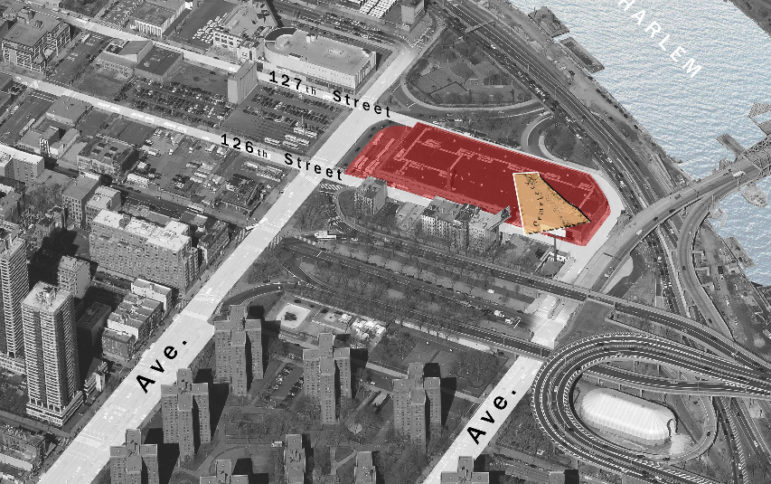
NYCEDC
An EDC map of the project site.
On Wednesday, the Economic Development Corporation (EDC) and the Department of Housing Preservation and Development (HPD) committed to ensuring that at least 50 percent of the apartments at the African Burial Ground project would be rent-restricted for families making below 80 percent AMI, with 20 percent for extremely low-income families making below 30 percent AMI, or $24,480 for a family of three. The city has not yet committed to ensuring the other 50 percent is rent-restricted.
EDC intends to redevelop the MTA bus depot on East 126th Street with a memorial for the recently discovered, desecrated remains of an African cemetery, along with a mixed-use project that includes roughly 730 units of housing. The city’s application to rezone the site to a high-density residential designation entered the Uniform Land Use Review Procedure (ULURP) in February. If approved by the City Council, EDC will issue a Request for Proposal (RFP) to find a developer.
The large site is immediately adjacent to the city’s proposed East Harlem rezoning, and has figured into discussions of how much rent-restricted—verses high-end—housing the De Blasio administration’s actions would bring to the neighborhood.
Some community advocates believe that the city should always mandate that development on the city’s dwindling public land should be 100 percent affordable.
At a hearing in September, members of Community Voices Heard and a representative from Manhattan Borough President Gale Brewer’s office said that the city should ensure that all the apartments are rent-restricted, while others expressed concern that a project of such magnitude might overshadow the memorial.
Though the city has not committed to 100 percent affordability and says the final affordability levels will depend on the outcome of the RFP process, the announcement that 20 percent of the apartments would be for families making below $24,480 won affirmative statements from Brewer and City Council Speaker Melissa Mark-Viverito in an EDC press release.
“Ensuring that this development will have apartments available for families earning 30 percent of AMI is incredibly important to help address some of the housing needs for East Harlem,” Brewer said. “I look forward to working with the community to create a memorial for the African Burial Ground that we can be proud of while developing a good open space plan.”
Diane Collier, chair of Community Board 11, also celebrated the news.
“It is clear from this announcement that NYCEDC and the city [are] moving in the right direction responding to CB11’s continual advocacy for development with deeper affordability and job creation for our East Harlem constituents,” she said in an e-mail to City Limits. “For more than 10 years, CB11 has been advocating for a befitting memorial for the Harlem African Burial Ground and the forgotten residents’ contribution to Harlem history. We will proceed building upon this good news as the project moves forward.”
But some neighborhood advocates say that as 38 percent of East Harlem households make less than $24,480, 20 percent of apartments is not enough, and that the city will be responsible for displacement if it does not increase the amount of apartments for this bracket.
Organizations like Community Voices Heard have already expressed disappointment that another public site in the neighborhood that the city intends to redevelop with 100 percent rent-restricted units will only set aside 20 percent of such units for families making below $24,480.
Another advocate called on the city to ensure the housing is developed by a mission-driven non-profit that would be committed to providing deep levels of affordability and to keeping the units rent-restricted forever. And Paula Segal of the Urban Justice Center, hoped a non-profit ownership structure would be used to protect the memorial part of the site.*
“This space will rely on the willingness of the developer and future management to keep it open to everyone unless the city retains title to the property,” she said in an e-mail to City Limits. “We hope that the RFP reflects an ownership structure for the memorial that puts control in public hands or a transfer of the deed to a mission-driven nonprofit. A memorial in private, for-profit hands is a huge risk.”
Roger Hernandez of El Barrio Unite said he opposed zoning changes that allows buildings higher than 12 stories, and continues to oppose the East Harlem neighborhood rezoning.
While the exact heights of the buildings have not been determined, for the purposes of environmental analyses the city imagines the project would include two buildings, one 34 stories and the other 19 stories.
*Correction: Originally implied that Paula Segal was speaking about the housing component of the site. In fact, she was referring in her e-mail to the memorial portion.









2 thoughts on “African Burial Ground Project Will Have Some Units for Extremely Low Income Families”
Is the burial site considered “communities space” for the developers?
Yes, the burial site will be considered “community space” thereby allowing the developers a “bonus” to build higher. What a way to defile a “sacred space”, with CB11 approval- Go figure…